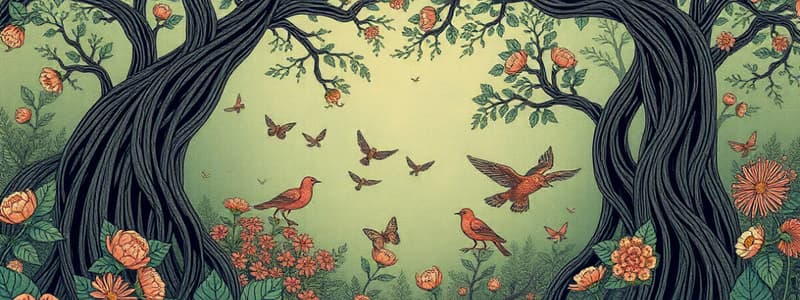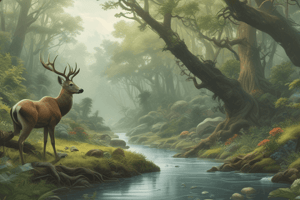Podcast
Questions and Answers
Lequel des scénarios suivants décrit le mieux une fluctuation de population dite « irruptive »?
Lequel des scénarios suivants décrit le mieux une fluctuation de population dite « irruptive »?
- Une population qui connaît une croissance exponentielle rapide, suivie d'une chute brutale. (correct)
- Une population qui décline progressivement sur une longue période.
- Une population dont la taille oscille régulièrement entre des valeurs hautes et basses.
- Une population qui croît lentement et de manière stable au fil du temps.
Parmi les facteurs suivants, lequel est un exemple d'aléa pouvant perturber la dynamique d'une population?
Parmi les facteurs suivants, lequel est un exemple d'aléa pouvant perturber la dynamique d'une population?
- Une augmentation soudaine de la température ou une inondation. (correct)
- Une relation prédateur-proie stable sur le long terme.
- Des variations saisonnières de la disponibilité en ressources.
- Un écosystème où les espèces sont bien adaptées à leur environnement.
Comment les activités humaines peuvent-elles influencer la dynamique des populations selon le texte?
Comment les activités humaines peuvent-elles influencer la dynamique des populations selon le texte?
- Par la destruction d'habitats, la pollution, la surexploitation et l'introduction d'espèces envahissantes. (correct)
- En augmentant systématiquement la biodiversité dans tous les écosystèmes.
- En ayant un impact marginal qui ne perturbe pas l'équilibre écologique.
- En ne causant que des changements positifs et contrôlables sur le long terme.
Quel facteur peut causer des fluctuations cycliques de type « boom-bust » dans une population?
Quel facteur peut causer des fluctuations cycliques de type « boom-bust » dans une population?
Selon le texte, quel est l'impact des changements climatiques sur les populations?
Selon le texte, quel est l'impact des changements climatiques sur les populations?
Quel facteur n'est PAS déterminant dans la dynamique des écosystèmes ?
Quel facteur n'est PAS déterminant dans la dynamique des écosystèmes ?
Parmi les propositions suivantes, laquelle décrit le mieux la colonisation d'un milieu par une espèce ?
Parmi les propositions suivantes, laquelle décrit le mieux la colonisation d'un milieu par une espèce ?
Lequel de ces facteurs n'est PAS déterminant pour qu'une espèce réussisse sa colonisation d'un nouveau milieu?
Lequel de ces facteurs n'est PAS déterminant pour qu'une espèce réussisse sa colonisation d'un nouveau milieu?
Quels sont les facteurs qui influencent la dynamique des populations?
Quels sont les facteurs qui influencent la dynamique des populations?
Quelle est la meilleure définition du taux de natalité au sein d'une population ?
Quelle est la meilleure définition du taux de natalité au sein d'une population ?
La présence de prédateurs dans un écosystème est un facteur qui influe principalement sur :
La présence de prédateurs dans un écosystème est un facteur qui influe principalement sur :
Lequel de ces événements est un exemple d'aléa pouvant affecter la colonisation d'un milieu ?
Lequel de ces événements est un exemple d'aléa pouvant affecter la colonisation d'un milieu ?
Comment appelle-t-on le phénomène où des individus quittent une population pour aller vers un autre environnement ?
Comment appelle-t-on le phénomène où des individus quittent une population pour aller vers un autre environnement ?
Flashcards
Dynamique des écosystèmes
Dynamique des écosystèmes
L'étude des interactions complexes et des transformations au sein d'un écosystème au fil du temps, impliquant les facteurs biotiques (organismes vivants) et abiotiques (composants non vivants).
Colonisation
Colonisation
Le processus par lequel une espèce s'établit dans un nouvel environnement.
Capacité de dispersion
Capacité de dispersion
La capacité d'un individu à se déplacer vers un nouvel habitat.
Adéquation environnementale
Adéquation environnementale
Signup and view all the flashcards
Dynamique des populations
Dynamique des populations
Signup and view all the flashcards
Taux de natalité
Taux de natalité
Signup and view all the flashcards
Taux de mortalité
Taux de mortalité
Signup and view all the flashcards
Immigration
Immigration
Signup and view all the flashcards
Fluctuations de population
Fluctuations de population
Signup and view all the flashcards
Cycles saisonniers
Cycles saisonniers
Signup and view all the flashcards
Fluctuations irruptives
Fluctuations irruptives
Signup and view all the flashcards
Cycles de boom-bust
Cycles de boom-bust
Signup and view all the flashcards
Aléas
Aléas
Signup and view all the flashcards
Study Notes
Ecosystem Dynamics
- Ecosystem dynamics encompass the complex interactions and transformations within an ecosystem over time.
- These dynamics involve both biotic (living organisms) and abiotic (non-living components) factors.
- Key aspects include energy flow, nutrient cycling, and species interactions.
Colonization of Environments by Species
- Colonization describes the process by which a species establishes itself in a new environment.
- Factors influencing successful colonization include:
- Dispersal ability: The capacity of individuals to move to a novel habitat.
- Environmental suitability: The match between the species' needs and the physical and biological conditions of the new area.
- Competition with other species: Presence of native species capable of outcompeting the newly arrived species for resources.
- Chance events: Disturbances or random events potentially favouring or hindering the colonizing species.
- Successful colonization frequently requires overcoming barriers or challenges, either physical or biological such as:
- Geographic barriers like mountains or oceans.
- Biological barriers such as the presence of specialized predators or competitors.
- Colonization can lead to significant changes in an ecosystem, potentially including the introduction of new species, alteration of community structure, and changes in ecosystem processes.
Population Dynamics
- Population dynamics are the changes in a population's size and structure over time.
- Factors influencing these dynamics include:
- Birth rate: The number of offspring produced per individual in a specific time period.
- Death rate: The number of deaths per individual over a specific time frame.
- Immigration: The arrival of individuals from another population to the population area.
- Emigration: The departure of individuals to another area.
- Competition: Individuals within the species compete for access to resources.
- Predation: The effect of predators on prey populations.
- Disease and parasites: Infections and infestations can significantly reduce population sizes.
- Environmental factors: Resource availability, climate conditions, and natural disasters influence survival.
- Population dynamics are influenced by a combination of biotic (biological) and abiotic (environmental) factors.
- Fluctuations in population size are often complex and influenced by interaction between these different factors.
Fluctuations in Species Abundance
- Population fluctuations (i.e. variation in population size) can be driven by environmental factors.
- Examples of fluctuations include:
- Seasonal cycles: Changes in birth and death rates in sync with environmental changes like temperature and food availability.
- Irruptive fluctuations: Exponential growth followed by a crash, usually due to resource availability.
- Boom-bust cycles: Alternating periods of high and low population density, often linked to predator-prey relationships (population size is higher when food is abundant and vice-versa).
Aléas de la Dynamique des Populations
- Random events (aléas) can significantly disrupt population dynamics.
- Examples of these random disturbances include:
- Natural disasters (e.g., floods, fires, storms): These events can drastically reduce or eliminate parts of a population, regardless of the species' characteristics.
- Disease outbreaks: Sudden increases in disease can decimate populations.
- Climate change: Altered temperatures and precipitation cause shifts in species distributions and alter the population behaviours over long periods.
- Human activities: Habitat destruction, pollution, overexploitation, or the introduction of invasive species can influence population dynamics in a multitude of ways.
- Stochasticity of birth and death events: Random variation in the number of births and deaths, independent of environmental conditions, can still impact population size.
Interconnectedness
- The different components discussed (colonization, population dynamics, environmental impacts etc.) continuously interact and influence each other.
- Changes in one component frequently affect the others, creating a complex and interconnected web within an ecosystem.
- Understanding these complex interactions is essential for managing and conserving ecosystems effectively.
Studying That Suits You
Use AI to generate personalized quizzes and flashcards to suit your learning preferences.




